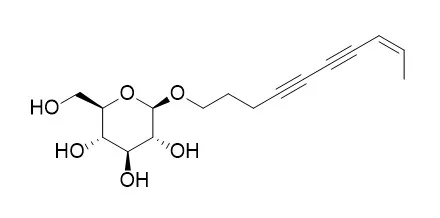| In vivo: |
| Journal of Liquid Chromatography & Related Technologies, 2015, 38(19):1740-1746. | | Pharmacokinetics of Five Different Types of Safflower Constituents in Rat Plasma after Oral Administration of Safflower Powder.[Reference: WebLink] | The petals of Carthamus tinctorius L. (safflower) is an important traditional medicine for promoting blood circulation and removing blood stasis. The pharmacokinetic properties of multiple safflower constituents have not been fully understood.
METHODS AND RESULTS:
In the present research, an ultra-high-performance liquid chromatography-triple quadrupole mass method in dynamic multiple reaction monitoring mode was developed and validated to simultaneously quantify in rat plasma of five different characteristic types of safflower constituents, including chalcone, poly-acetylene, glycoside of 6-hydroxykaempferol, etc. All the five constituents, hydroxysafflor yellow A, Bidenoside C, 6-hydroxykaempferol-3,6-diglucoside, chlorogenic acid, and p-coumaric acid were detected in rat plasma after oral administration of safflower powder. p-Coumaric acid was the most quickly absorbed one with Tmax of 0.1 hr. The poly-acetylene constituent, Bidenoside C, displayed the largest AUC0-t value (2177.796 ng · h/L) followed by hydroxysafflor yellow A (1564.1 ng · h/L).
CONCLUSIONS:
The impressively favorable pharmacokinetic behavior of Bidenoside C reported herein for the first time rendered the importance for paying more attention to its role in the in vivo pharmacologic effects of safflower. | | BMC Complement Altern Med, 2016 Jun 13;16:179. | | Hepato-protective effects and chemical constituents of a bioactive fraction of the traditional compound medicine-Gurigumu-7.[Pubmed: 27296281] | Gurigumu-7 is an important traditional Mongolian medicine frequently used for liver diseases. However, the pharmacological effects and the bioactive constituents are not well understood.
METHODS AND RESULTS:
This research was to use CCl4-induced liver damage in mice to investigate the hepatoprotective effects of Gurigumu-7 and the methanol eluted fraction from a DIAION column of an extract of Gurigumu-7 (MF). The chemical constituents of MF were analyzed by UPLC-MS.
Pretreated orally with MF (66, 132 and 264 mg/kg) once a day for 4 days dose-dependently suppressed CCl4-induced mice liver histopathological changes and serum aminotransferase activities (alanine transaminase: 1144.0 ± 787.2 v.s. 2461.8 ± 1072.7 U/L, p < 0.05; aspartate transaminase: 1173 ± 785.3 v.s. 2506.6 ± 1140.7 U/L, p < 0.01). MF treated group demonstrated increased levels of SOD (108.19 ± 30.32 v.s. 75.75 ± 5.37 U/mg protein, p < 0.01) but decreased levels of malonyldialdehyde (7.68 ± 1.95 v.s. 44.32 ± 16.68 nmol/mg protein, p < 0.01) compared to the CCl4 control group. More than 30 chemical constituents were quantified, and MF was found to be rich in ellagic acid (297.97 mg/g), luteolin and its glucosides (35.10 mg/g), apigenin and its glucosides (>30 mg/g), ursolic acid (14.91 mg/g), Bidenoside C (8.75 mg/g), and proanthocyanidins (15.64 mg/g in proanthocyanidin A2 equivalent).
CONCLUSIONS:
The methanol eluted fraction (MF) from a DIAION column of an extract of the Mongolian medicine-Gurigumu-7 was found to be more hepatoprotective than Gurigumu-7. The results suggested that MF is a promising bioactive fraction for the development of new hepatoprotective medicine with better formulation and quality control properties. |
|






 Cell. 2018 Jan 11;172(1-2):249-261.e12. doi: 10.1016/j.cell.2017.12.019.IF=36.216(2019)
Cell. 2018 Jan 11;172(1-2):249-261.e12. doi: 10.1016/j.cell.2017.12.019.IF=36.216(2019) Cell Metab. 2020 Mar 3;31(3):534-548.e5. doi: 10.1016/j.cmet.2020.01.002.IF=22.415(2019)
Cell Metab. 2020 Mar 3;31(3):534-548.e5. doi: 10.1016/j.cmet.2020.01.002.IF=22.415(2019) Mol Cell. 2017 Nov 16;68(4):673-685.e6. doi: 10.1016/j.molcel.2017.10.022.IF=14.548(2019)
Mol Cell. 2017 Nov 16;68(4):673-685.e6. doi: 10.1016/j.molcel.2017.10.022.IF=14.548(2019)